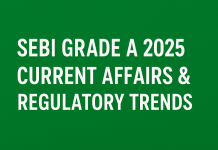Monetary Policy of RBI
Monetary policy refers to the use of monetary instruments under the control of the central bank to achieve the goals specified in the Reserve Bank of India Act, 1934. The Reserve Bank of India (RBI) is vested with the responsibility of formulating and regulating the monetary policy. This responsibility is explicitly mandated under the Reserve Bank of India Act, 1934.
The goal(s) of Monetary Policy
The main objective of RBI monetary policy is to preserve the price stability while keeping the growth objective in mind. The stability of prices is an essential precondition for sustainable growth.
The Reserve Bank of India (RBI) Act, 1934 was amended in May 2016 to provide a statutory basis for the implementation of the flexible targeting framework for inflation.
The amended RBI Act also provides for the inflation target to be set once every five years by the Government of India, in consultation with the Reserve Bank. Therefore, in the Official Gazette, the Central Government reported 4% inflation in the Consumer Price Index (CPI) as the target for the period from 5 August 2016 to 31 March 2021, with an upper tolerance limit of 6% and a lower tolerance limit of 2%.
As factors that constitute a failure to achieve the inflation target, the Central Government reported the following:
- The average inflation for any three consecutive quarters is greater than the upper tolerance level of the inflation target; or
- For every three consecutive quarters, the average inflation is lower than the lower tolerance level.
Prior to the amendment to the RBI Act in May 2016, the flexible inflation targeting framework was governed by the Government-Reserve Bank of India Monetary Policy Framework Agreement of 20 February 2015.
The Monetary Policy Process
The Monetary Policy Committee (MPC) established under Section 45ZB by the Central Government shall determine the policy interest rate required to meet the inflation target.
The Monetary Policy Department (MPD) of the Reserve Bank helps the MPC formulate monetary policy. The views of key stakeholders in the economy and the Reserve Bank’s analytical work contribute to the decision-making process on the policy repo rate.
The Financial Market Committee (FMC) meets daily to review the conditions of liquidity in order to ensure that the monetary policy operating target (weighted average lending rate) is kept close to the repo rate of the policy.
RBI Monetary Policy: 2021
The Monetary Policy Committee met within days of the Union Budget 2021 presentation and decided to keep key interest rates unchanged.
Brief Summary
- The Monetary Policy Committee of the Reserve Bank of India has kept the policy rate unchanged at 4 percent and unanimously voted to maintain the status quo with an accommodative stance.
- RBI Governor Shaktikanta Das also said that for the coming fiscal year, the RBI projects India’s GDP growth rate will be 10.5 percent. Governor Das said, “The outlook for growth has improved significantly, with positive growth impulses becoming more broad-based and the implementation of the country’s vaccination program auguring well for the end of the pandemic.” For the current quarter of this fiscal year, the MPC projects retail inflation at 5.2 percent on the inflation front, well within the RBI tolerance band limits.
- Together with the MPC announcements, the Reserve Bank of India has also shed light on other measures the central bank is working on to strengthen the financial system. After opening Gilt accounts with the RBI, the RBI Governor said the central bank is working to allow retail investors to invest in government securities.
- RBI also enabled foreign portfolio investors (FPI) to invest in security receipts and debt instruments issued by Asset Reconstruction Companies. RBI Governor Das assured markets that even though he discussed restoring the cash reserve ratio, the central bank will continue to maintain ample liquidity (CRR).
Major Highlights
- Unchanged Policy Rates
For the fourth straight meeting since May, the Monetary Policy Committee voted unanimously to keep the repo rate unchanged at 4 percent. Separately, the central bank that controls the reverse repo rate decided to keep it unchanged at 3.35%.
- Investment in Government Bonds directly
Through a new direct investment option offered by the central bank, retail investors will now have greater access to the government bond market.
- Normalization of CRR In Two Steps
While keeping rates unchanged, after the Covid-19 crisis hit, the RBI decided to reverse the Cash Reserve Ratio cut announced in March 2020. RBI Governor Shaktikanta Das said the CRR normalization would leave room for the central bank to implement other liquidity management tools.
- Inclusion of NBFCs in TLTRO
Under the targeted long-term repo operations scheme, the Reserve Bank of India will enable banks to extend credit to non-banking finance companies. This will help to provide NBFCs with liquidity.
- RBI Projects FY22 Real GDP At 10.5%, CPI Inflation At 5.2% In Q4 FY21
Growth is recovering, and with the implementation of the vaccine program in the country, the outlook has improved significantly, the Monetary Policy Resolution said. However, the recovery is still to gain firm traction and therefore continued support for policy is crucial.
The MPC stated in its resolution that the sharp food price correction has improved the outlook for food prices, but some pressures persist and core inflation remains high. With pump prices of petrol and diesel at historic highs, the unwinding of taxes on petroleum products by both the center and the states could ease the cost-push pressures.
To know the detailed policy and the related questions for RBI Grade B exam click here:
RBI’s Monetary policy Feb 2021
ixamBee has launched RBI Grade B Exclusive Comprehensive Online Course to make your RBI Grade B exam preparation a well-rounded experience. RBI Grade B Exclusive Online Course is curated as per the NEW exam pattern announced by RBI in its 2021 notification for Grade B officers. Our experts have covered thoroughly descriptive papers for ESI and FM in the course content.
Also read:
RBI: Financial Stability Report 2021
RBI Grade B 2021: How to Approach ESI Descriptive Paper?
Achieve the Perfect Score – 30 out of 30 in Quant!
Get Free Online Test Series, GK updates in form of Beepedia, as well as latest updates for Bank PO, Bank Clerk, SSC, RBI, NABARD and Other Government Jobs.
веб займ телефонзайм под залог москвазайм до 50000 рублей













